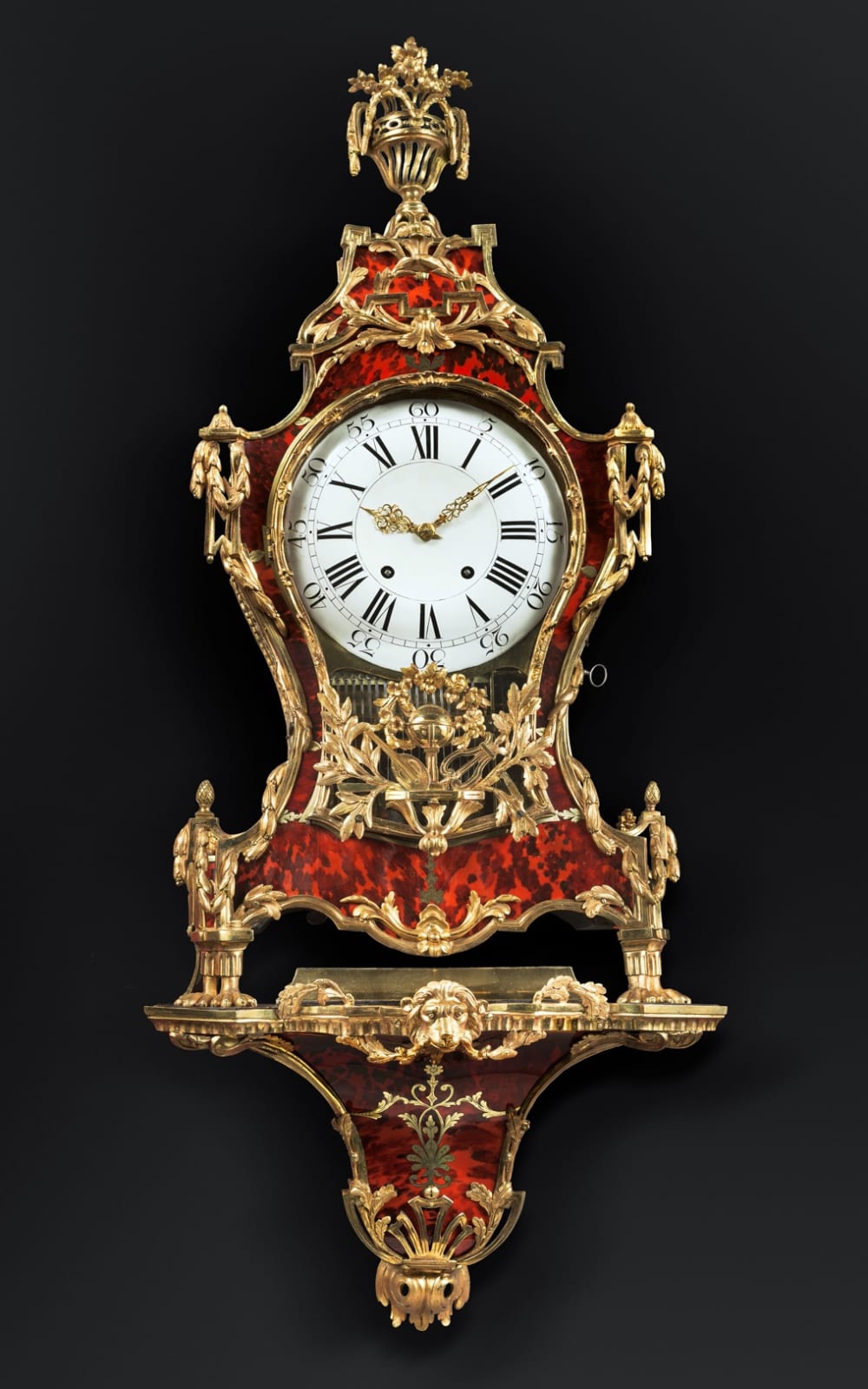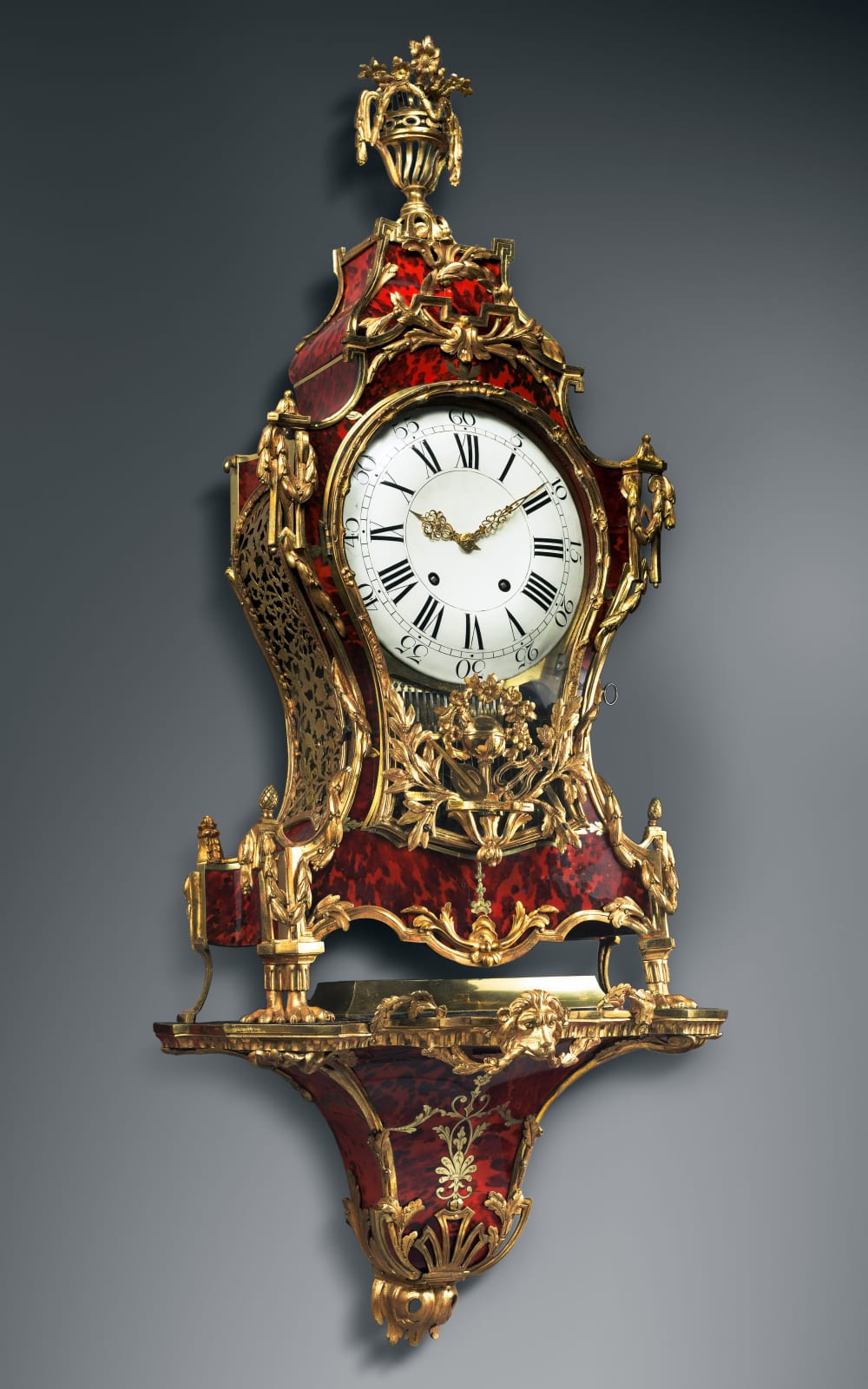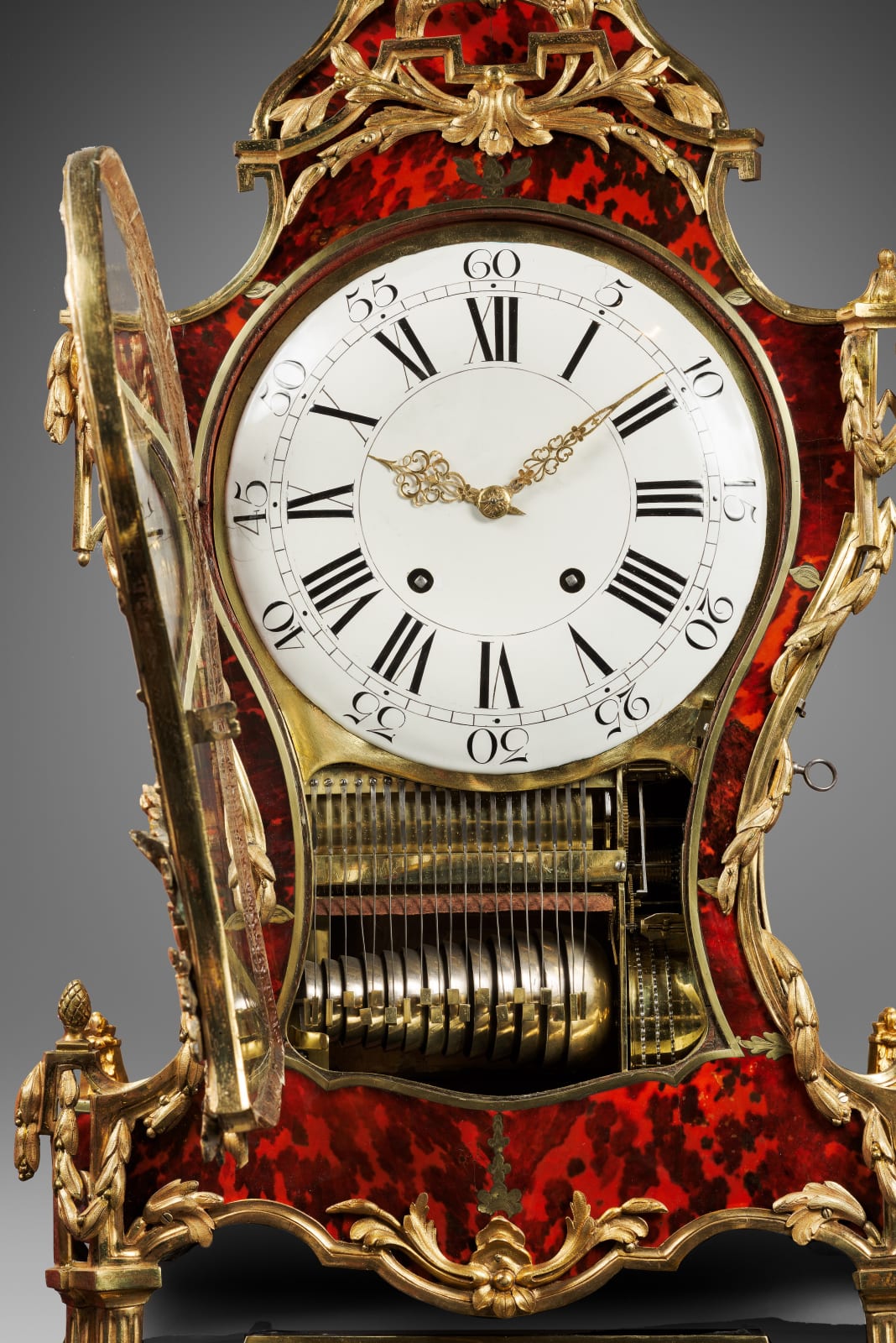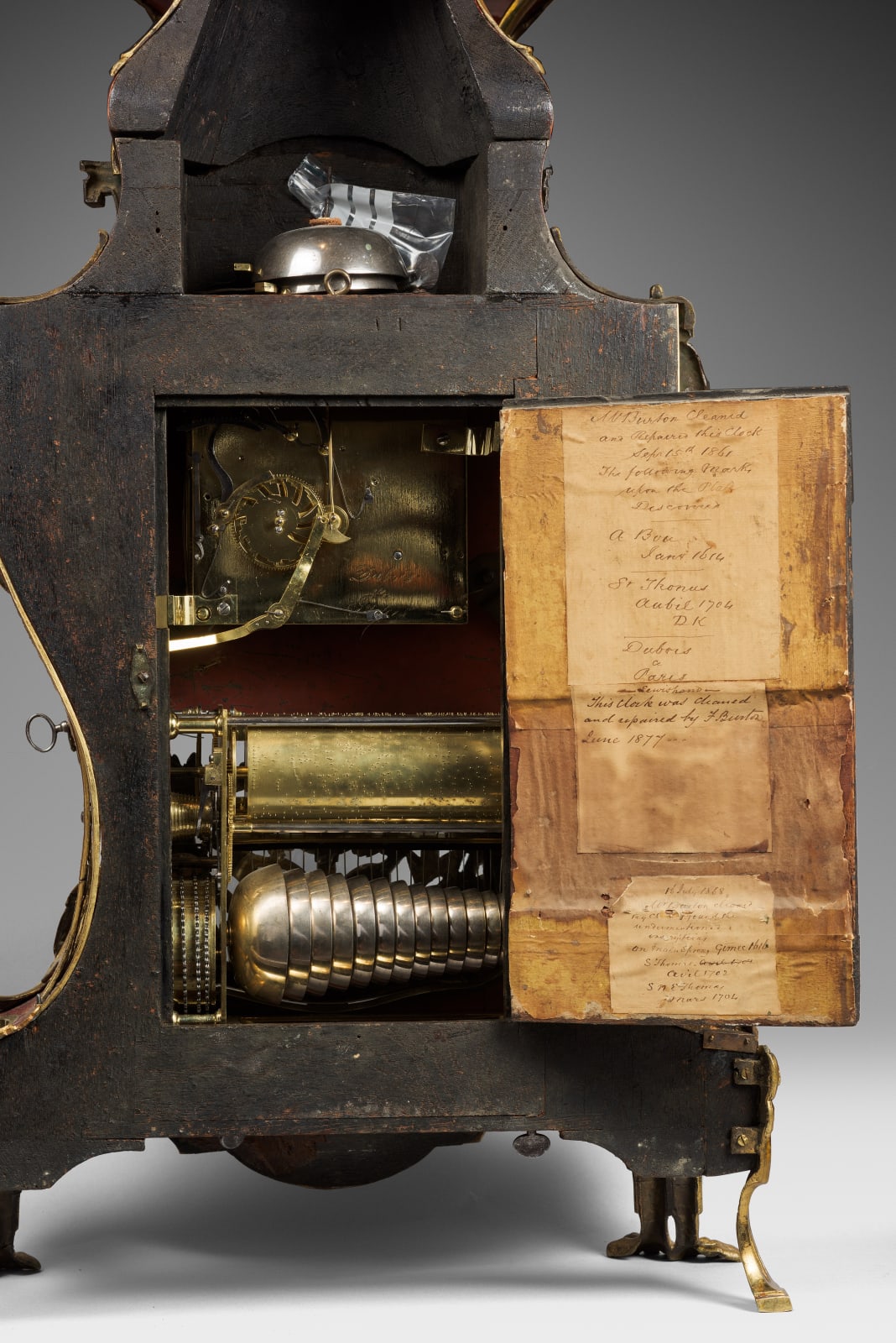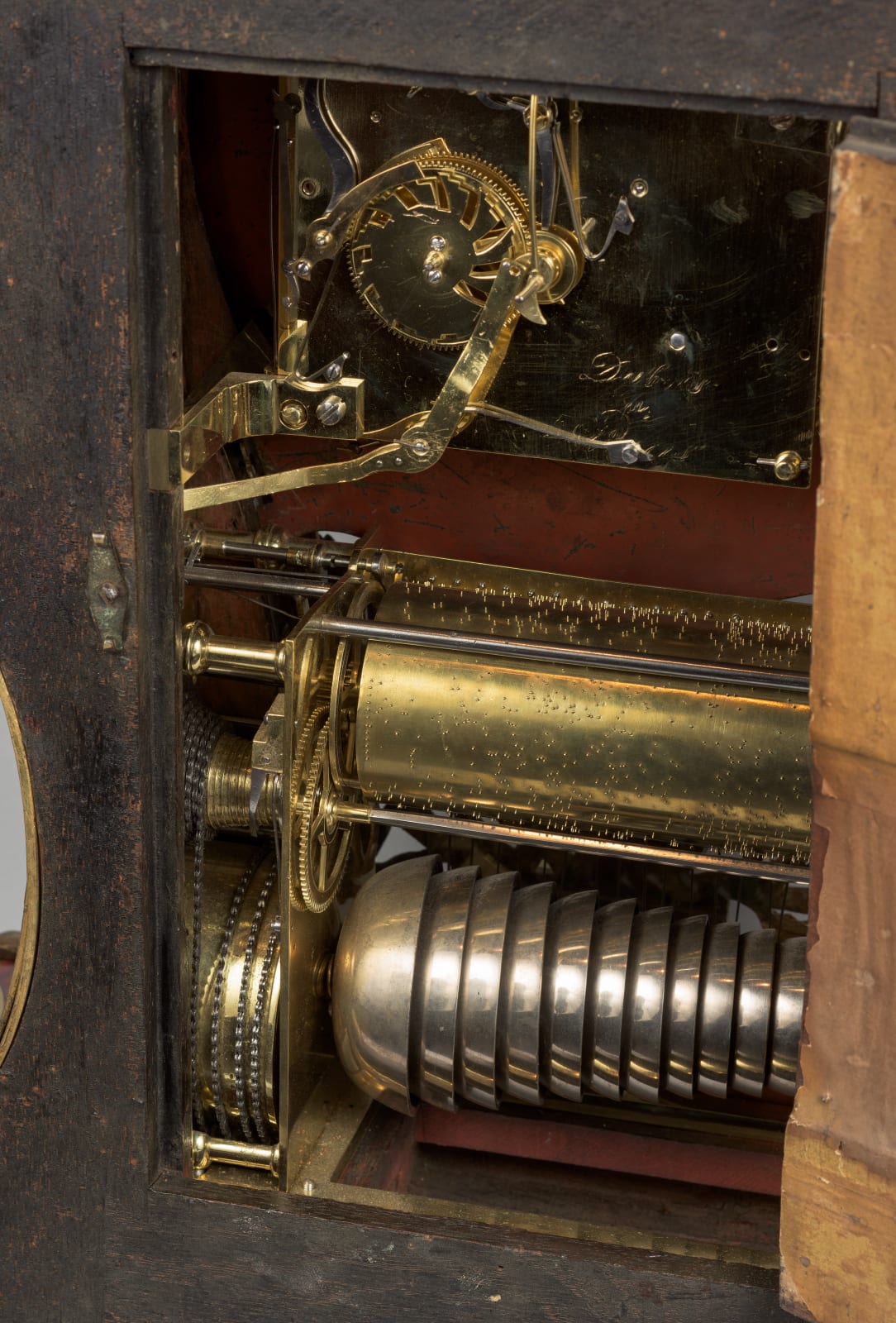Denis-Frédéric Dubois
Further images
Literature
Hans Ottomeyer and Peter Pröschel, “Vergoldete Bronzen”, 1986, p. 158, pl. 3.2.7, illustrating a similar cartel with bracket with movement by Denis-François Dubois and case by François Duhamel and decorated with extremely similar gilt bronze mounts including a pair of ram’s heads rather than a lion head on the bracket.
Pierre Kjellberg, “La Pendule Française du Moyen Age au XXe Siècle”, 1997, p. 88, pl. D, illustrating a similar cartel and bracket with dial as here unsigned but with case stamped by the ébéniste François Duhamel.
A rare and extremely beautiful Louis XV gilt bronze mounted red tortoiseshell musical grand cartel clock with bracket of twelve day duration by Denis-Frédéric Dubois housed in a magnificent case attributed to François Duhamel, indistinctly engraved on the backplate Dubois à Paris and inscribed on separate pieces of paper attached to the inside of the rear door:
“Mr Burton cleaned/ and repaired this clock/ Sept 15th 1861/ The following mark/upon the plate/Discovered/a Bou/Janr 1614/St Thomas/aubil 1704/DK/Dubois a Paris/Servishand [?]/This clock was cleaned and repaired by F. Burton/June 1877/16 July 1868/Mr Burton cleand my clock & found the under mentioned inscriptions/ On mainspring Gimec 1616/S Thomas Avil 1702/ S N E Thomas Mars 1704”.
The white enamel dial with Roman and Arabic numerals with a very fine pair of pierced gilt brass hands for the hours and minutes. The massive twin barrel movement, one for the going and the other for the striking, with anchor escapement, spring suspension, striking on the hour on a single bell and on the quarters on two bells, with outside strike wheel. The pin barrel for the music, powered by a large rectangular chain fusee movement, playing eight tunes on thirteen bells via twenty hammers. The superb oak-carcase tortoiseshell case of waisted outline surmounted by a pierced gilt bronze flower-filled vase hung with a foliate swag above small pilasters with berried laurel leaf swags flanking the upper part of the dial and mounted below the dial with a globe upon a stand crowned by flowers and flanked by a lyre and lute upon a stand issuing berried laurel sprays, the splayed base again with elaborate mounts including laurel leaf sprays and pinecone finials above pilaster supports, the front ones with conjoined lion paw feet, each of the sides with doors enclosing beautiful foliate pierced sound frets, the shaped bracket centred at the top with a lion head holding a foliate spray in its mouth above further foliate sprays and a foliate boss
Paris, date circa 1765-70
Height 131 cm, width 52 cm.
This rare grande cartel clock is not only distinguished by its beautiful case and matching bracket but by its musical movement that plays eight tunes. Furthermore it features part of its history as inscribed by a past owner on sheets of paper fixed to the rear door. That explains that the movement was made by Dubois à Paris whose name is inscribed on the backplate of the movement. The name refers to the Parisian clockmaker Denis-François Dubois, who died after 1791 and came from a renowned French horological dynasty. His grandfather was the clockmaker Pierre Dubois while his father was François Dubois (b.1732 d. after 1772) who worked for ten years as a compagnon to Julien as well as Pierre II Le Roy, François Béliard and Voisin fils. Denis-François Dubois, who married Marie-Madeleine Beaudet, was received as a Parisian maître in September 1767; by 1772 he was established at rue des Cordeliers and then in 1783 at rue des Fossés-Monsieur-le-Prince. Specialising as a maker of very fine clocks, he made movements for a number of Louis XV and Louis XVI period examples with earlier veneered cases supplied by the ébéniste François Duhamel (1723-1801) and later gilt bronze examples by the fondeur Nicolas Bonnet.
The present case can confidently be attributed to François Duhamel not only on account of its exceptional quality but also its similarity to other cartels on brackets that bear his stamp. Among them are examples cited under literature (above) as well as another painted brass veneered case, as here featuring musical trophies below the dial, which was once owned by this gallery (illustrated in “Richard Redding Antiques Ltd, Masterpieces of the Past”, 2004, p. 107). Francois Duhamel, who became a maître-ébéniste in 1750, specialised in the creation of high quality clock cases and like other noted Parisian ébénistes settled in the Faubourg-Saint-Antoine area. Of considerable talent he produced a range of cases in various styles. Some, as here, marked a transition between the Louis XV and Louis XVI styles to incorporate the curvaceous lines and asymmetrical ornament of the Louis XV period with more classical elements from the Louis XVI period such as the surmounting vase, the laurel leaf swags as well as the lion paw feet and lion head on the bracket. At the beginning of his career he produced cases veneered in tortoiseshell or exotic woods. However from about 1765 onward, when the fashion for cartel and mantle clocks housed in pure gilt bronze cases came into vogue and largely replaced veneered examples, Duhamel, like Balthazar Lieutaud, Antoine Foullet and other specialist ébénistes, began selling gilt bronze clock cases.
As noted the restoration of this clock was undertaken by F. Burton, who was almost certainly Frederick Burton, a watchmaker and jeweller of 25 Mercer Row, Louth in Lincolnshire, England, who for instance repaired a mid nineteenth century silver verge watch which is now in the British Museum. Accompanying that watch are several of F. Burton’s small circular watch papers which, featuring a royal crest with a lion and unicorn, advertised the fact that his business undertook “Chronometer, Duplex, Lever and Geneva Watches Correctly Repaired”. We know that Burton restored and cleaned the present clock in 1868 and again in 1877 which would explain why at that stage it was fitted with an English anchor escapement and an English pendulum. We can also assume that the owner of the clock at that period lived in or near to the market town of Louth. Among such properties was Thorpe Hall, a large stately mansion which in the 1860s and 1870s was owned by John Lewis Fytche (1816-1903). He served as High Sherriff, was related to the poet Alfred Lord Tennyson and owned a fine collection of paintings, furniture and other works of art.
